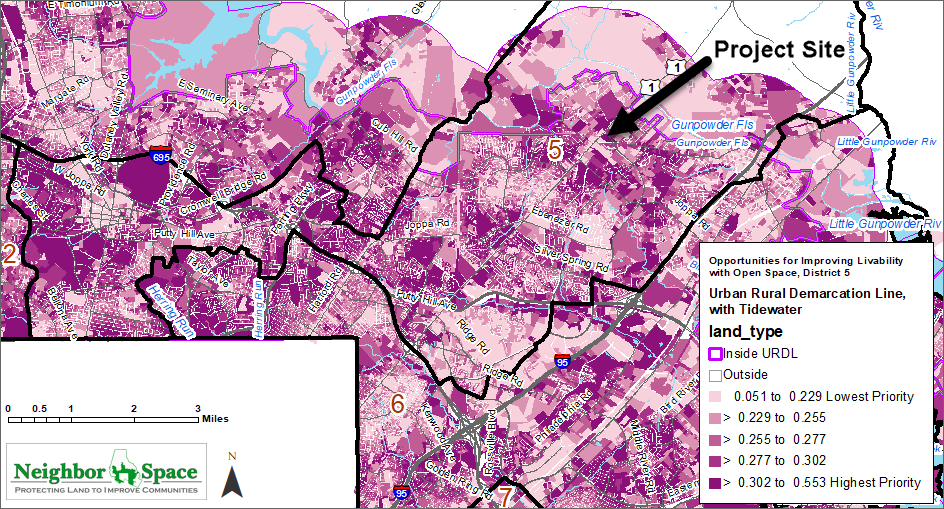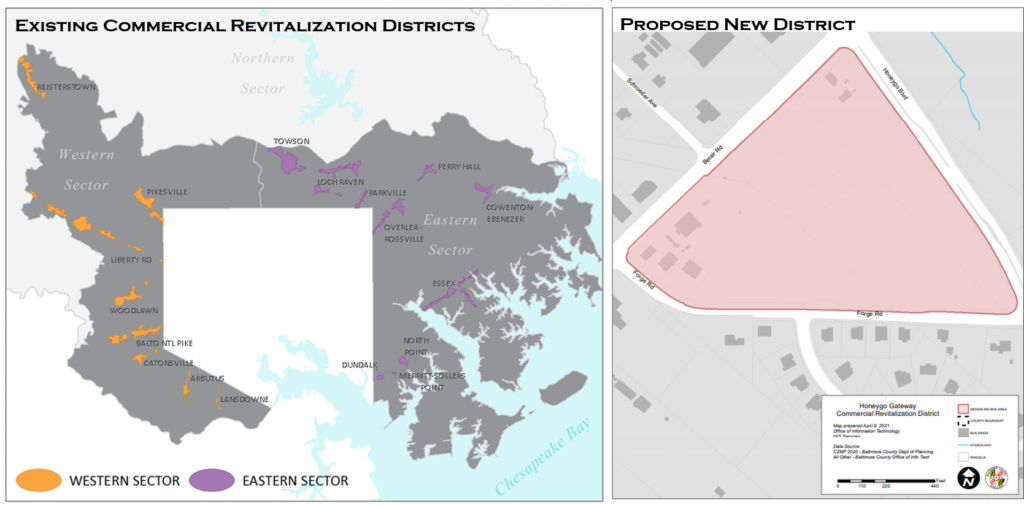By Klaus Philipsen, FAIA, Board President and Barbara L. Hopkins, Esq., ASLA, Executive Director
 It is a good thing when community members, a developer and a councilman come together to find consensus on development, especially when the agreement includes hard-core, anti-development neighbors. It is also good to replace additional strip commercial development with much needed housing. This is, in part, what happened when the Southern Land Company, and representatives of the surrounding communities, agreed on a plan for a 1.49-acre parcel on the Southeast corner of Belair Rd. and Honeygo Blvd. in Perry Hall. It was not surprising, then, that Councilman Marks presented the outcome as a success in the Council work session this last Tuesday.
It is a good thing when community members, a developer and a councilman come together to find consensus on development, especially when the agreement includes hard-core, anti-development neighbors. It is also good to replace additional strip commercial development with much needed housing. This is, in part, what happened when the Southern Land Company, and representatives of the surrounding communities, agreed on a plan for a 1.49-acre parcel on the Southeast corner of Belair Rd. and Honeygo Blvd. in Perry Hall. It was not surprising, then, that Councilman Marks presented the outcome as a success in the Council work session this last Tuesday.
What is not good, is when such a consensus gets cast into a Council bill and eliminates all the land use regulations, zoning, and required offset fees, which are in place to protect the public, to benefit a single piece of land and a single developer. When NeighborSpace spoke out against Bill 46-21 and the compendium Resolution 67-21, we were cast as outside interlopers who rained on the parade at the last minute. (In point of fact, no one involved in the nine months of consensus-building ever mentioned the discussions to us. We found out owing to our practice of reviewing the Council website regularly).
To understand why NeighborSpace took the risk of being seen as the skunk at the garden party, it is necessary to understand a few basic facts about development:
- Practically all the land in Baltimore County is subject to zoning;
- When somebody doesn’t like the zoning, a rezoning application can be filed every four years;
- If rezoning somehow doesn’t fit the bill, one can apply for a planned unit development that creates its own set of standards but has more oversight in the approval process; and
- If one part of a lot should be commercial and the other residential (as in this case), one can also subdivide the land and rezone only one portion.
But none of this was done in this case. Instead, the Councilman introduced legislation that intends to create its own rules for this parcel, a result that should give us all pause. Here’s why:
WHAT DOES THE LEGISLATION DO & WHY SHOULD YOU CARE?
The bill and resolution are symptoms of a systemic disease that has plagued the County for decades, becoming the bane of residents and developers alike. The disease is called “ad hoc lawmaking,” legislating for a limited purpose without regard for the contents of comprehensive and community plans, for established zoning rules, and for other important provisions based in federal Constitutional law that are there to protect the public from the adverse impacts of development.
For other symptoms, one need only look as far as the County Code and the Zoning Code. They have been rendered so impenetrable and obtuse by these long-standing practices that only their drafters, aided in no small way by legions of developers’ attorneys, can understand them. And the whole process perpetuates itself, year upon year, owing to the unfortunate principle known as “Councilmanic Courtesy,” which, translated, means “I won’t question your zoning bills if you don’t question mine.”
Because the disease is systemic, moreover, its impacts are far-reaching and they are very harmful, so much so that the patient is now on life support. That’s what led us to speak out against the legislation last week, offering the following reasons why we hope that other council members and our loyal readers will realize that it is not in their interests to sit idly by while this legislation heads toward passage:
1. The Legislation is Likely Illegal
There is a strong case to be made that the legislation could be rejected should it be challenged in court because it is unlawful “spot” or “contract” zoning, an agreement between the developer and the zoning authority (the County Council), which is illegal, because, among other things, it grants the property owner a special privilege not available to others and interferes with the government’s exercise of its police powers, a case we will definitely make in the paragraphs that follow.
2. If It Passes, the Legislation Will Set Legal Precedent for What Could Happen in Your Neighborhood
If this bill and resolution become law, they set legal precedent, establishing that it is okay for the County Council to take the Executive Branch out of its traditional review role and to set aside rules requiring developers to pay their fair share of the costs of development. The end result is that existing taxpayers are left to pick up the tab and developers and their attorneys are invited to employ these same tactics in your community.
3. The Legislation Represents Really Bad Public Policy
By legislative fiat, the review process that is in place to protect the public from the adverse consequences of development, along with the requirement that developers pay their fair share of the costs of open space and schools, are taken out of play, cast aside like yesterday’s news. Simultaneously, development standards designed to control land use and spur commercial development are watered down. Let’s look at each of these issues in turn.
A. Exemption from Development Review
The bill exempts the project from the traditional development review process, which requires the submission of plans to the County and several levels of review and public comment, and instead requires approval by way of what is known as a “limited exemption” under Section 32-4-106(B)(2) of the County Code. The scale of this project (and its deviation from the approved development plan) far exceed what is typically reviewed as a limited exemption, such as the construction of one, single-family dwelling or the building of an accessory structure like a garage. There are good, sound public policy reasons for review by qualified members of municipal agencies. That is a proper exercise of a government’s federal, Constitutional police powers, long-standing authority to protect the public from the adverse impacts of development, and we should be incensed and deeply troubled when such review is set aside so cavalierly!
B. Exemption from Contributing to the Cost of Public Facilities
Bill 46-21 exempts the project from complying with County open space requirements under Section 32-6-108 of the County Code and also from paying impact fees under Section 32-6-111. Like the requirement for review, these provisions have a similar legal and Constitutional basis designed to protect the public from the adverse impacts of development. When you look at Perry Hall, moreover, you find examples of the very problems these laws were designed to address. Let us explain.
(1) Setting Aside the Open Space Requirement
At the Work Session testimony was offered that setting aside the open space requirement is warranted because there are four parks nearby. We learned, moreover, that the developer has agreed to make his project more attractive by installing benches, sidewalks, fire pits, dog stations and grills, and also to provide a $15,000 contribution to Angel Park.
Developers making their own development more attractive should never count as providing open space or paying related fees so that open space can be provided elsewhere. Even in Perry Hall where there are several parks, moreover, access to them other than by car is still a problem. The website “walksore.com” gives the area an overall walk score of 28, a rating that means “car dependent.” Development plans should never forget that more than half the population lacks the ability to drive because they are too young, too old, too poor, too impaired or otherwise have no car readily available to them.
But these rebuttals really only scratch the surface of what is wrong with setting aside the open space requirement. The real problem is that, because open space is a very pressing problem inside the County’s older communities (i.e., inside the Urban Rural Demarcation Line (URDL)), current law requires the developer to provide open space or pay a fee to the County. (In the interest of full disclosure, 20 percent of the fees collected come to NeighborSpace). Eighty percent of the fees collected go to the Department of Recreation and Parks and it is incumbent upon it to use that fee for open space within the Councilmanic District. And in spite of the testimony offered at the work session, there are plenty of open space needs in the district. The map below, which comes from the NeighborSpace GIS model, shows where the protection of open space should be prioritized to create positive social, economic, and environmental livability outcomes, by, for example, providing recreational space, buffering streams, and improving property values. The needs are myriad. Benches, sidewalks, and fire pits are not open space. Moreover, existing law should determine the fee, not the developer and the Councilman, and the Department of Recreation and Parks should be permitted to decide how that fee is used to address the many livability challenges shown in the map below.

(2) Setting Aside Impact Fees
Section 32-6-111 of the County Code requires new residential development to pay its proportionate fair share of the costs for land, capital, facilities, and other expenses necessary to accommodate development impacts on infrastructure and public school and public safety facilities. Let us not forget what led to this provision in our law, enacted just a few short years ago. The County was facing a dire budget situation, particularly when it comes to paying for the renovation and construction of its schools. In fact, the school overcrowding situation in Perry Hall is what led to the instant proposal for age-restricted housing. How little sense it makes then, to turn around and exempt this project from paying impact fees.
C. The Watering Down of Legal Standards
Resolution 67-21 creates a Commercial Revitalization District on the site. It is hard to see how “revitalization” applies to a largely undeveloped plot of land. The Resolution doesn’t clarify this except to say that “the County Council finds that there exists a need for assistance to the property owners and businesses in the aforementioned area in order to stimulate public and private investment and renewed interest from surrounding residents and others in the community.”
As the County website and the program brochure for Revitalization Districts show, moreover, the program is targeting the often failing older commercial corridors, never a single corner property or largely vacant, unbuilt land, as is the case here. In spite of the fact that the program is managed by the Planning Department, there was no testimony offered by the Department in favor of this new district to which it will be required to dedicate a planner. Should the resolution be approved, moreover, the developer will be eligible to apply for a five-year and possibly even a ten-year credit against property taxes. There are sound public policy reasons for providing tax benefits to developers that revitalize older commercial corridors like those shown in the map below, left. But no evidence has been mustered to suggest that the southeast corner of Belair Rd. and Honeygo Boulevard, shown in the map below, right, is one of them.

WHAT CAN YOU DO?
What happened here is not an isolated case. We recently wrote about another project, wherein the developer was permitted to meet the open space requirement by providing various amenities to a neighboring community where there was no open space shortage. The value of those amenities exceeded $300,000, over three times what the County collected in open space waiver fees last year. And there are many, many more examples like that one.
None of this will change unless citizens hold their elected officials accountable. We urge you to:
(1) Contact your council representative and ask him or her to vote against these two pieces of legislation, or at least to abstain from voting, when the Council next meets on Thursday, May 27 at 10 AM. If you don’t know who your representative is, you can find out here. In addition, you can send your comments to the entire Council at countycouncil@baltimorecountymd.gov.
(2) Ask the County Executive to veto the legislation should it pass. You can reach the County Executive at: johnnyo@baltimorecountymd.gov or at 410-887-2450.
(3) Share this post with others you think might be interested and able to help.
Pingback: More, Really Bad Public Policy - NeighborSpace of Baltimore County
Pingback: Baltimore County has a disease: It’s called ‘councilmanic courtesy.’ - yorkais.xyz